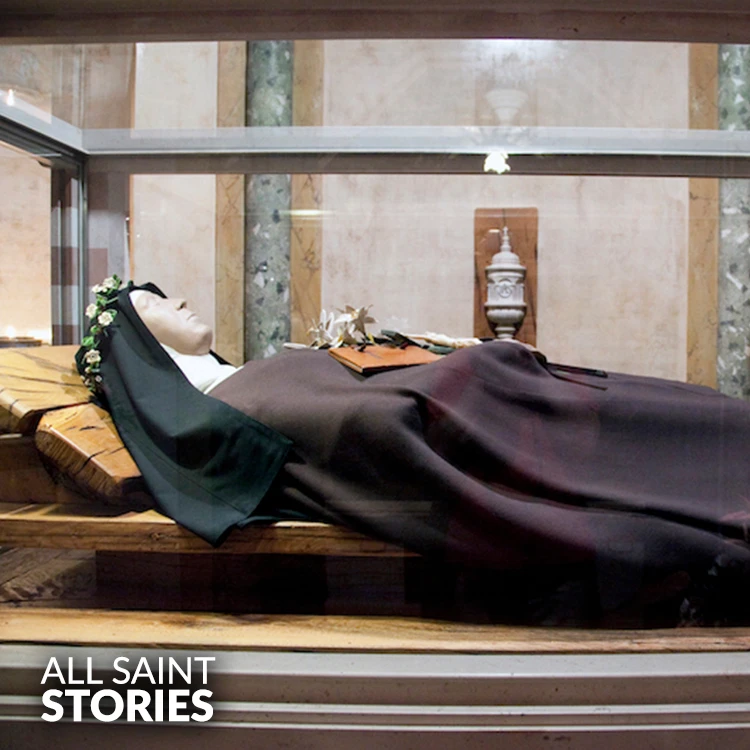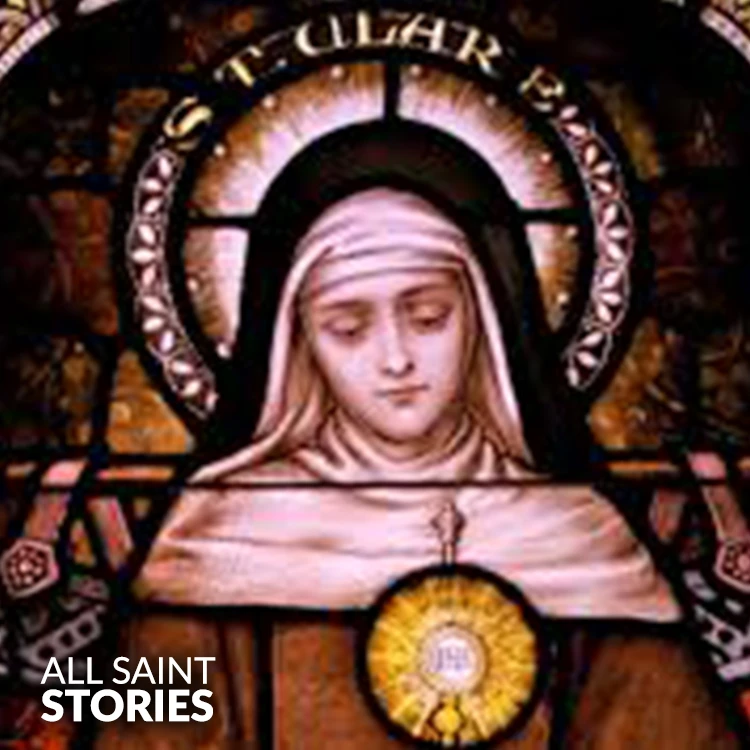"Saint Clare, you who lived a life of faith and simplicity, intercede for us in our times of need. Help us to live with love, humility, and devotion to God, just as you did. May your example of courage and trust inspire us to follow Christ with unwavering commitment. Pray for us, Saint Clare, that we may always seek God's will in our lives. Amen."
ST. CLARE OF ASSISI
ST. CLARE OF ASSISI

St. Clare of Assisi was a 13th-century Italian nun and the foundress of the Poor Clares, a monastic order dedicated to poverty and prayer. Inspired by St. Francis of Assisi, she renounced her noble life to follow Christ, embracing a life of simplicity, humility, and deep devotion.
St. Clare of Assisi was born on July 16, 1194, into a noble family in Assisi, Italy. From a young age, Clare exhibited a deep sense of spirituality and compassion for the poor. Inspired by the radical Gospel lifestyle preached by St. Francis of Assisi, she secretly left her family home at the age of 18 to dedicate her life entirely to Christ. On the night of Palm Sunday in 1212, she fled to the Porziuncola, where Francis welcomed her and gave her the simple habit of his followers, initiating a lifelong commitment to poverty and service.
Clare’s act of defiance against her family’s expectations and her noble status marked a profound turning point in the role of women in the Church. She soon attracted other women, including her sister Agnes, to this new way of life. They took residence at the Church of San Damiano, which Francis had rebuilt earlier in his ministry. There, Clare established the Order of Poor Ladies, the second Franciscan order, dedicated to living in strict poverty, manual labor, and contemplative prayer. The order was later renamed the Poor Clares in her honor.
Clare’s leadership was marked by strength, humility, and a deep mystical connection with God. She resisted efforts from Church authorities to soften the severe poverty that she and her sisters had vowed to uphold. For over forty years, she governed the community and remained firm in her insistence on the "privilege of poverty," even as others, including the papacy, urged her to accept financial support or property for her monastery.
One of the most dramatic episodes of her life occurred during an attack by Saracen mercenaries on Assisi. According to tradition, Clare, though ill and weak, confronted the invaders with the Blessed Sacrament in her hands and prayed for divine intervention. The attackers miraculously retreated, and the monastery was spared. This event solidified Clare’s legacy as a woman of unwavering faith and courage.
Clare’s health declined significantly in her later years due to her rigorous ascetic lifestyle, but her spiritual strength never wavered. She continued to guide her sisters, write spiritual instructions, and correspond with Francis and other religious figures. Two days before her death on August 11, 1253, Pope Innocent IV approved her Rule—the first religious rule written by a woman to be officially recognized by the Church.
Clare was canonized remarkably quickly, just two years after her death, by Pope Alexander IV on September 26, 1255. Her spiritual daughters, the Poor Clares, continue her legacy around the world today, living lives of cloistered prayer and evangelical poverty.
In 1958, Pope Pius XII named her the patron saint of television, inspired by a story that she was once miraculously able to see and hear Mass on the wall of her room when she was too ill to attend. She is also invoked as the patroness of eye diseases and for those seeking clarity and light in darkness.
Clare’s life remains a model of radical discipleship, feminine strength in faith, and unwavering trust in God’s providence. Her legacy is intricately bound to the Franciscan movement and continues to inspire countless people who seek a life of simplicity, service, and prayer.
Video Not Found
The information on this website is compiled from various trusted sources. While we aim for accuracy, some details may be incomplete or contain discrepancies.
If you notice any errors or have additional information about this saint, please use the form on the left to share your suggestions. Your input helps us improve and maintain reliable content for everyone.
All submissions are reviewed carefully, and your personal details will remain confidential. Thank you for contributing to the accuracy and value of this resource.
Credits & Acknowledgments
- Anudina Visudhar (Malayalam) – Life of Saints for Everyday
by Msgr. Thomas Moothedan, M.A., D.D. - Saint Companions for Each Day
by A. J. M. Mausolfe & J. K. Mausolfe - US Catholic (Faith in Real Life) – Informational articles
- Wikipedia – General reference content and images
- Anastpaul.com – Saint images and reflections
- Pravachaka Sabdam (Malayalam) – Saint-related content and insights
We sincerely thank these authors and platforms for their valuable contributions. If we have unintentionally missed any attribution, please notify us, and we will make the correction promptly.
If you have any suggestion about ST. CLARE OF ASSISI
Your suggestion will help improve the information about this saint. Your details will not be disclosed anywhere.
© 2025 Copyright @ www.allsaintstories.com






 English
English
 Italian
Italian
 French
French
 Spanish
Spanish
 Malayalam
Malayalam
 Russian
Russian
 Korean
Korean
 Sinhala
Sinhala
 Japanese
Japanese
 Arabic
Arabic
 Portuguese
Portuguese
 Bantu
Bantu
 Greek
Greek
 German
German
 Dutch
Dutch
 Filipino
Filipino